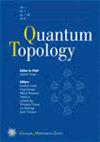柄体底缠结的Kontsevich积分
IF 1
2区 数学
Q1 MATHEMATICS
引用次数: 12
摘要
利用类似于Andersen, Mattes和Reshetikhin给出的构造的Kontsevich积分对手体内缠结的推广,我们构造了一个函子$Z:\mathcal{B}\to \widehat{\mathbb{A}}$,其中$\mathcal{B}$是手体内底缠结的范畴,$\widehat{\mathbb{A}}$是手体内Jacobi图的范畴$\mathbb{A}$的补全度。作为一个对称的一元线性范畴,$\mathbb{A}$是支配“Casimir Hopf代数”的线性PROP,它是具有原始不变对称2张量的协交换Hopf代数。函子$Z$诱导正则同构$\hbox{gr}\mathcal{B} \cong \mathbb{A}$,其中$\hbox{gr}\mathcal{B}$是$\mathcal{B}$上Vassiliev-Goussarov过滤的相关梯度。对于每个Drinfeld关联子$\varphi$,我们将$\hbox{gr}\mathcal{B}$中的一个带状拟Hopf代数$H_\varphi$关联起来,并证明了$H_\varphi$通过“嬗变”得到的辫状Hopf代数正是辫状范畴$\mathcal{B}$中正则Hopf代数的$Z$的像。最后,我们解释$Z$是如何改进LMO函子的,LMO函子是一个扩展Le-Murakami-Ohtsuki不变量的类tqft函子本文章由计算机程序翻译,如有差异,请以英文原文为准。
The Kontsevich integral for bottom tangles in handlebodies
Using an extension of the Kontsevich integral to tangles in handlebodies
similar to a construction given by Andersen, Mattes and Reshetikhin, we
construct a functor $Z:\mathcal{B}\to \widehat{\mathbb{A}}$, where
$\mathcal{B}$ is the category of bottom tangles in handlebodies and
$\widehat{\mathbb{A}}$ is the degree-completion of the category $\mathbb{A}$ of
Jacobi diagrams in handlebodies. As a symmetric monoidal linear category,
$\mathbb{A}$ is the linear PROP governing "Casimir Hopf algebras", which are
cocommutative Hopf algebras equipped with a primitive invariant symmetric
2-tensor. The functor $Z$ induces a canonical isomorphism $\hbox{gr}\mathcal{B}
\cong \mathbb{A}$, where $\hbox{gr}\mathcal{B}$ is the associated graded of the
Vassiliev-Goussarov filtration on $\mathcal{B}$. To each Drinfeld associator
$\varphi$ we associate a ribbon quasi-Hopf algebra $H_\varphi$ in
$\hbox{gr}\mathcal{B}$, and we prove that the braided Hopf algebra resulting
from $H_\varphi$ by "transmutation" is precisely the image by $Z$ of a
canonical Hopf algebra in the braided category $\mathcal{B}$. Finally, we
explain how $Z$ refines the LMO functor, which is a TQFT-like functor extending
the Le-Murakami-Ohtsuki invariant
求助全文
通过发布文献求助,成功后即可免费获取论文全文。
去求助
来源期刊

Quantum Topology
Mathematics-Geometry and Topology
CiteScore
1.80
自引率
9.10%
发文量
8
期刊介绍:
Quantum Topology is a peer reviewed journal dedicated to publishing original research articles, short communications, and surveys in quantum topology and related areas of mathematics. Topics covered include in particular:
Low-dimensional Topology
Knot Theory
Jones Polynomial and Khovanov Homology
Topological Quantum Field Theory
Quantum Groups and Hopf Algebras
Mapping Class Groups and Teichmüller space
Categorification
Braid Groups and Braided Categories
Fusion Categories
Subfactors and Planar Algebras
Contact and Symplectic Topology
Topological Methods in Physics.
 求助内容:
求助内容: 应助结果提醒方式:
应助结果提醒方式:


